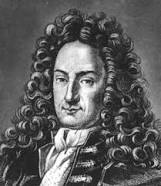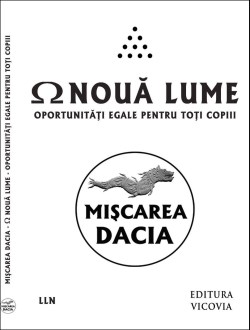 Vă invit să vă alăturaţi grupului Facebook Mişcarea DACIA, ce-şi propune un alt fel de a face politică!
Vă invit să vă alăturaţi grupului Facebook Mişcarea DACIA, ce-şi propune un alt fel de a face politică!Citiţi partea introductivă şi proiectul de Program, iar dacă vă place, veniţi cu noi !
O puteţi face clicând alături imaginea, sau acest link
Posts Tagged ‘Newton’
Hyperian History Of The World (17th Century, Part 2)
Hyperian History Of The World (17th Century, Part 2)
The 17th Century saw the true rebirth of philosophy; philosophy finally freed from the constraints of christianity. But the century also saw the birth of modern science, which would move even further away from the ideas of religion.
The heliocentric theory of the universe developed by Copernicus in the previous century had, of course, been utterly rejected by the church, and many other thinkers and intellectuals had trouble accepting this idea which ran contrary to centuries of thought. However, slowly but surely, the idea crept into the minds of scientists who began to rethink the very way in which they might understand the universe.
Philosophers such as Descartes and Spinoza tended to think in a more mathematical way, thus developing rationalist systems more akin to the ancient greek thinkers. Scientists (or ‘Natural Philosophers’ as they were known then) thought differently. Perhaps scientists were more extroverted individuals in general, but, for whatever reason, rather than thinking rationally within their own minds, scientists looked outwards into the physical world around them, basing their ideas merely on their own observations.
The man often regarded as the father of modern science was the Italian Galileo Galilei. Galileo began to make observations and to perform experiments to support his theories. Experiments sometimes revealed that long standing theories about physics were in fact incorrect. For example, Aristotle had said that an object’s weight determines the speed at which in falls to the ground. Given the reputation of Aristotle, his theory was accepted and never tested for well over a thousand years. Galileo, however, decided to experiment. There is a story (probably not true) which tells of Galileo dropping canon balls of varying sizes from the top of the leaning tower of Pisa and measuring their speed. It is more likely that Galileo actually carried out a more simple experiment but, regardless, the results showed that, no matter the weight of the balls, they all fell to earth at the same speed, contrary to what Aristotle had said.
The fact that a simple experiment could easily prove wrong an idea which had been accepted for such a long time showed that this new, experimental method of science could achieve great things. Galileo’s observational method also proved successful. Thanks to the invention of the telescope, scientists and astronomers could get a much closer look at the heavens and thus could begin to better understand what was going on up there. Using a telescope, Galileo observed the planet Jupiter and realised that there were several smaller bodies which seemed to be orbiting around the planet. This was a momentous discovery, as it seemed to vindicate the heliocentric theory of Copernicus, as well as the complex cosmology of Giordano Bruno. If other planets have moons orbiting them, then the Earth really ceases to be anything special in the universe. We are simply one planet of many orbiting the sun, each other planet having its own smaller system of orbiting moons.
As a result of his observations, Galileo accepted the heliocentric model, which was still controversial. His writings about it attracted the church’s inquisition who tried him and, in 1633, found him to be suspect of heresy. Knowing what had happened to Giordano Bruno, Galileo decided to recant his ideas, thus sparing his life, but he remained under house arrest until his death in 1642. The church still had some power, but they were weakening. Galileo was not killed as Bruno had been, and, despite his recanting, his heretical ideas could not be stopped and began to spread and become more and more accepted. The church were losing their grip and they couldn’t very well keep everyone under house arrest.
Galileo’s methods of observation and experimentation brought about a revolution for science, yet his theories still amounted to little more than speculation. Galileo seemed to be suggesting that the universe was like some kind of huge machine, which operated according to certain laws. But Galileo was simply observing these laws in action, he was not precisely stating what the laws were. More rigour was required for science to get really serious. The rationalist philosophical system of Descartes had a decidedly mathematical underpinning, given that Descartes was a brilliant mathematician. Mathematics was the very quintessence of rationalism that seemed to have little to do with the observational, experimental methods of scientists such as Galileo. However, in a bizarre twist of fate, one scientist turned precisely to mathematics in order to give science much more rigour. This was Isaac Newton.
Newton is a rather strange figure in this history. Despite science seeming to move away from christianity, and Newton playing such an important role in it, he nonetheless remained almost fanatically christian for all his life. In his religious writings, Newton revealed that he regarded himself to be almost like a religious prophet, sent by god to reveal the workings of the universe to humanity. As such, despite the huge impact he had on science, Newton’s theories, from the beginning, were tainted by religious ideas. Rather than build a system of truth from the ground up as did Descartes and Spinoza, or to draw conclusions based upon observations as did Galileo, Newton presupposed certain religious ideas (such as the existence of the christian god) and skewed his theories so as to ‘prove’ those ideas to be true.
For example, Newton is often regarded as the man who ‘discovered’ gravity. Yet when Newton was asked how gravity could possibly work instantaneously even over vast distances, he simply stated that Gravity was god’s will at work, and god can do anything he wants! This hardly seems like science at all, yet Newton is revered by scientists all over the world to this day.
Ultimately, Newton’s theories amount to simple approximations about the physical universe. Being only approximations, these theories can be expressed with rather simple mathematical formulas, yet these formulas give Newton’s science a greater sense of rigour than any scientist had given before. As such, Newton’s science became accepted the world over and was not challenged for centuries, despite his theories being only approximations and despite many of his theories relying on religious ideas taken only on irrational faith!
Despite science seeming to free humanity from the clutches of christianity, Newton’s science has in fact set humanity back for centuries. Newton’s theories were literally too good to be true, yet few were intelligent enough to realise this. Whilst it was a great step forward to mathematise one’s theories, this only works if one’s theories are correct to begin with, and Newton’s simply weren’t. However, in Newton’s own lifetime, there was one who saw through him, one who developed a philosophy based on theories which were correct but who, despite his best efforts, failed to mathematise his theories, not because he lacked the skill, but because his theories were so complex and ahead of their time that the mathematics required to explain them simply hadn’t been discovered. It is this individual who ought to be celebrated as humanity’s greatest genius, but we shall return to him in a later chapter of this history.
– Brice Merci

Mathematicos (6)
Cuvinte și Numere
„Adevărul refuză cuvintele create de om pentru a-l descrie. Rezultatul Cuvintelor este Mytos… Credință, Opinie, Interpretare… concepte omenești ale Realității.
Antidotul este Logos. Dacă Mythos este Cuvântul, Logosul este Numarul. Ne apropiem cu atât mai mult de Adevăr, cu atât mai mult cu cât folosim Numerele Ontologice pentru a-l descrie. Singularitățile zero / infinit nu pot fi ignorate în niciun sistem Logos.
Textele Religioase sunt false deoarece nu folosesc Matematica (Numerele). Știința e poziţionată mai bine decât Religia pentru că o face, dar o face incomplet, nefolosind TOATE Numerele, alunecând în filosofia greșită (Mythos) a Empirismului și Materialismului.
Matematica Abstractă este inferioară Matematicii Ontologice deoarece, ca şi Ştiința, nu reușește să definească și să utilizeze corect Numerele.
„Lucrarea lui Descartes a fost punctul culminant al unui proces de eliberare a Algebrei de Cuvinte, după cum Geometria greacă a eliberat Construcțiile de Numere. Odată ce a oferit un formalism pentru descrierea relațiilor algebrice, progresul a fost rapid. După patruzeci de ani de la publicarea Geometriei Algebrice a lui Descartes, filosoful german și matematicianul Gottfried Wilhelm von Leibniz (1646-1716) a creat o Algebră a Infinitului. Aceasta este ceea ce numim „Calculul”, un instrument puternic pentru analiza Creșterii și a Schimbării.
Isaac Newton (1642-1727) a făcut o descoperire echivalentă mai înainte, dar el a extins doar notația lui Descartes, mai degrabă decât să-l depășească, așa că este forma leibniziană de Calcul, cea care predomină astăzi. Astfel, au fost doi filozofi, Descartes și Leibniz [Mike Hockney: Idealist-Rationalişti!], care au creat Notaţiile și Ideile care au format Matematica de atunci. … Procesul de a găsi cât de repede se schimbă Cantitatea se numește Diferențiere. Când Diferenţiem o funcție, obținem rata de Schimbare a acesteia. “– Ziauddin Sardar și Jerry Ravetz”
Mintea și Corpul
Cum se relaţionează Mințile la Corpuri? Dacă Mințile controlează cu adevărat Corpurile (cum se pare că fac), cum se explică? Răspunsul este Transformarea Fourier care permite funcțiilor matematice dintr-un Domeniu de Frecvență în afara Spațiului și Timpului (un domeniu mental) să fie reprezentate ca funcții materiale în spațiu și timp (un domeniu fizic).
Materialismul Ştiințific nu poate ajunge la această concluzie matematică simplă, deoarece neagă existența unui domeniu mental neobservabil, fără dimensiuni, în afara spațiului și timpului.
Transformarea Fourier stă la baza Mecanicii Cuantice și Holografiei. Mai mult sau mai puțin, toate problemele științei ar dispărea dacă oamenii de știință ar accepta realitatea ontologică a Transformărilor Fourier care unește două Domenii Matematice: unul în spațiu și timp (Materie – Corp) și altul în afara spațiului și timpului (Mintea).
Transformarea Fourier este exemplul arhetipal al locului în care matematica se ciocnește cu metoda experimentală a științei, care Ştiință alege să susțină Experimentele în locul Matematicii. Dacă ar inversa această politică, știința ar deveni matematică și toate absurditățile Empirismului ar fi depășite.
Știința este îngrozită de faptul că Realitatea este împărțită în două categorii radical diferite (mintea neobservabilă și materia observabilă), deoarece metoda științifică se adresează numai uneia dintre ele (materie observabilă). Totuși, Transformarea Fourier este un instrument matematic fundamental care demonstrează că nu puteți avea o Realitate care nu se împarte în două domenii inter-conexe, transformabile.
Știința nu a reușit niciodată să înțeleagă ce înseamnă cu adevărat Transformarea Fourier. Dacă s-ar întâmpla, ar vedea că nu are altă posibilitate decât să accepte Ontologia Dualistă (de fapt Monismul cu dublu aspect) asociată cu Transformarea Fourier – un domeniu observabil (al materiei) și un domeniu neobservabil (mintea), care dă naștere acesteia (materia).
Știința spune că nu există Minți, ci doar Materie, care dă naștere la Minte. Leibniz a spus că există infinite minți matematice care dau naștere la fenomenul materiei. El ar fi invocat Transformarea Fourier pentru a-și explica sistemul, dacă ar fi fost cunoscut în zilele lui. Pentru Leibniz, nu există Substanțe Materiale, doar Fenomene Materiale care derivă din Minţile Matematice (adevăratele Substanțe ale Existenței).
Adevărul
„Ființele umane, prin schimbarea Atitudinilor Interioare ale Minții lor, pot schimba Aspectele Exterioare ale vieții lor” – William James
Lucrul pe care trebuie să-l schimbați mai presus de toate este atitudinea voastră față de Adevăr. Trebuie să vă întrebați ce fel de caracter trebuie să aibă Adevărul și cum putem avea acces la el. Avem oare acces la Adevărul etern prin Sentimentele, Simțurile, Intuițiile noastre, sau prin Rațiunea noastră? Dacă Adevărul nu se referă la Sentimente, este inutil să vă aduceți Sentimentele la căutarea Adevărului. Același lucru este valabil și pentru Simțuri.
Este Adevărul în „Conștiența Golită” (prin Meditaţie în religiile orientale)? Ce inseamnă asta? „Conștienţa Golită” se referă la o stare ipotetică, empirică a Minții. Are o legătură exact Zero cu Adevărul etern, necesar, cognoscibil și inteligibil.
Când îl caută, oamenii caută de regulă altceva decât Adevărul. Ei vor ca lucrurile să le hrănească Simțurile, Sentimentele și Intuițiile și nu au decât dispreț pentru Rațiune (Martin Luther – „Raţiunea e o curvă a Diavolului”). Cu toate acestea, numai Raţiunea este despre Adevărul etern, necesar. 1 + 1 = 2 este cea mai Adevărată declarație pe care ați făcut-o vreodată. Este Adevărat dintotdeauna, chiar şi dinainte de apariţia Omului în Univers, spre deosebire de toate Sentimentele, Senzațiile, Ipotezele, Credințele, Opiniile, Experiențele, Interpretările și Intuițiile Mistice.
„Nu putem niciodată să știm totul. … Nu poți ajunge până la sfârșitul Înțelegerii, dar puteți înțelege întotdeauna mai mult. “- Tara Shears
Din contră, cu siguranță putem cunoaște toate lucrurile și înțelege totul… Matematic.
Numai Matematica poate fi înțeleasă pe deplin și definitiv și, dacă Realitatea este matematică (așa cum este și cum trebuie să fie), atunci Realitatea însăși poate fi înțeleasă pe deplin și definitiv.”
Tags: Adevăr, Corp, Credinţa, Descartes, Frecvenţe, Leibniz, Matematica Ontologică, Minte, Monism, Mytos, Newton, Numere, Religie, Singularitate, Transformate Fourier












